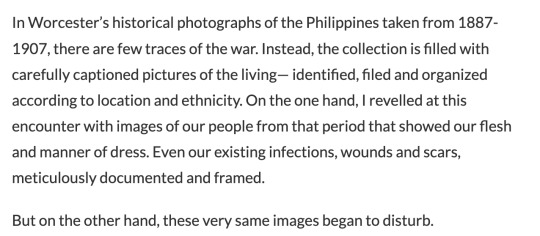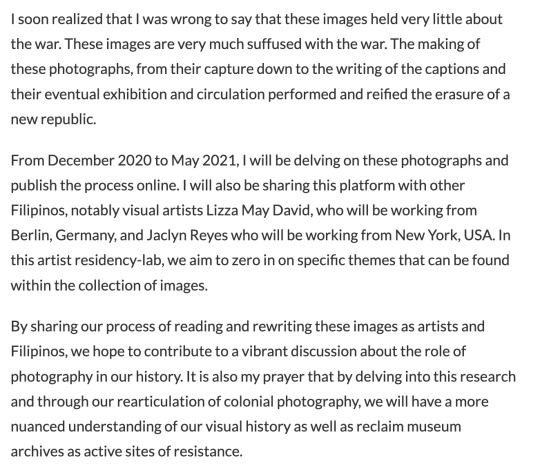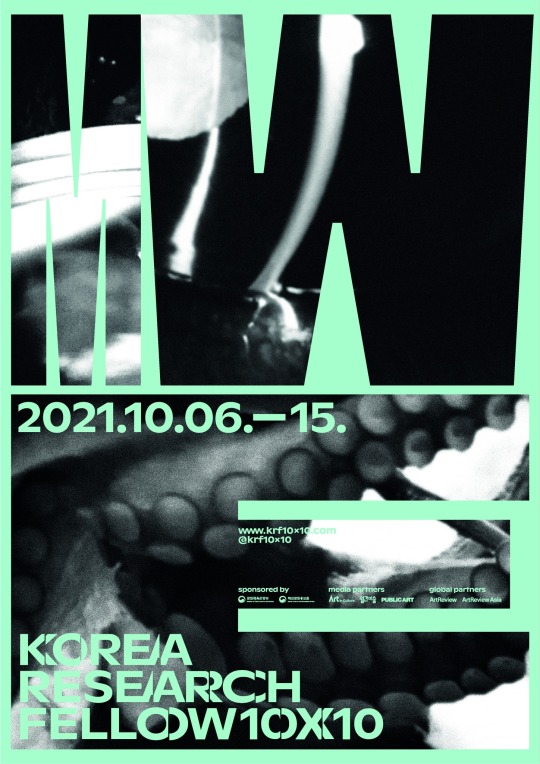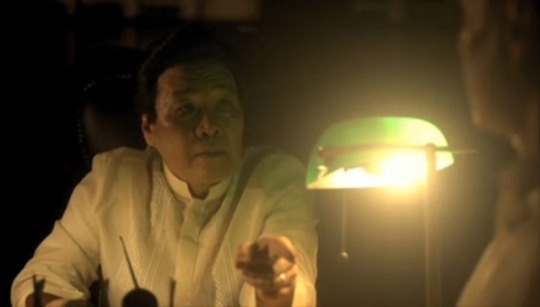#Kiri Dalena
Explore tagged Tumblr posts
Text
Tipp: Kiri Dalena - im neuen Berliner Kunstverein
7. Dezember 2024 – 2. Februar 2025 | Eröffnung: Freitag, 6. Dezember, 19:00?Uhr Der Neue Berliner Kunstverein (n.b.k.) präsentiert die erste Überblicksausstellung der Filmemacherin und Aktivistin Kiri Dalena in Europa. Dalenas dokumentarischer Stil zeichnet sich durch eine besondere Nähe zu ihren Protagonist*innen aus: Die Künstlerin setzt sich seit über 20 Jahren für die Wahrung von…
#Ausstellung#Einzelausstellung#Exhibition#Filmemacherin#Kiri Dalena#Kunstausstellung#Manila#Manuela Mordhorst#n.b.k.#Neuer Berliner Kunstverein
0 notes
Text



From MCAD Manila Instagram Page: A troubled preadolescent returns to her mother’s womb amid the strain of home and turmoil of social life in Drestel Galang’s darkly surreal narrative experiment conceived at the height of state-sponsored extrajudicial killings in Duterte’s Philippines. The Cave (Puke ng Ina) by Drestel Galang is part of the HISTORIES screenings on Saturday, 16 Sept. 2023, Day 3 of the MCADxMovingImage: Worlds We Are.
Screenings start at 1 PM, and will feature a talk with Shireen Seno, Drestel Galang, Kiri Dalena, Sari Dalena, and Lara Acuin. An all-access pass valid for all three days is available for Php300.
Image credit: The Cave (Puke ng Ina), Still, 2019
21 notes
·
View notes
Text
Snare for Birds
Snare for Birds: Rereading the Colonial Archive is a collaborative research art project of Kiri Dalena, Lizza May David, and Jaclyn Reyes that inquire into the tangents of the country’s colonial past, archiving, and its impacts on being Filipina. Distinct in their own practice, each artist negotiates their own and the current generation’s positions against an imperial past and present as women residing in the Philippines, Germany, and the United States. The project builds upon the deeply embedded imagery and knowledge of Dean Worcester; whose photos were eventually bought by German merchant Georg Küppers-Loosen and is part of the Rautenstrauch-Joest Museum’s archive in Cologne, Germany. Worcester, an ornithologist and Secretary of Interior of the Philippine Islands during the American colonial period, was known for his book The Philippine Islands and their People. Worcester’s views shaped US public opinion, foreign policy, and inevitably what we know to be Filipino history and identity. Snare for Birds: Rereading the Colonial Archive challenges these deeply embedded imagery by reciprocating Worcester’s endeavor: to engage with archival images like specimens and to claim truths a camera was “made to tell.” It encourages viewers to question the colonial gaze, the accessibility of these historical records, and the ways in which our responses to these images shape how we engage with our predecessors. Finally, it asks what these images imply and reveal about Filipinos today considering that these have historically been used as evidence of Filipinos’ incapability of self-governance. Since the collaboration began in 2020, Dalena, David, and Reyes have paved their own paths of inquiries while converging through thought partnership as seen on their website (https://www.snareforbirds.com). This act of working together in itself has become its own decolonizing ritual, as they intentionally interrupt the disembodiment of the global Filipino diaspora through piecing together parts of fragmented histories and solidarities. The final iteration of the project to be mounted at the Ateneo Art Gallery is seen neither as a conclusion nor culmination of the research; rather, it is perceived to be a preamble for more avenues of conversations to ensue. Snare for Birds: Rereading the Colonial Archive is a look at our collective history in order to deal with the present with hopes of forging a just and equitable future. The colonial past, though riddled with pain and adversity, requires persistent disruptions not only to dislocate power structures but to also re-define what is known to be truths.
Source: Ateneo Art Gallery
An excerpt from Kiri Dalena


I did not duplicate the photographs for this entry in respect to the work of the artists. Please enter the website if you would like to see them.
Each artist has a section with trigger warnings before you can proceed to the artworks. Dalena features several photographs of indigenous Filipinos during the early years of the American colonial period. The people are depicted as specimen to be studied; their way of dress is shown, their flesh, various ailments, and infections. Dalena points out that while the photographs are not of the usual carnage from the Philippine-American war, they still contain implicit violence, as is eerily characteristic of colonisation. Colonisation armed with the sophistication of science and academia seems to be more sinister. In Edward Said's Orientalism, Napoleon's conquest of Egypt is cited as the start of such form of violence, with scientific and academic structures leading the way. This is how the Americans came to us.
Annotation 1
This reminded me of a friend's research essay where she describes how the lexicon of photography is quite violent. Capture. Shoot. Exposure. Aberration.
Annotation 2
Archival work as a form decolonisation and reclamation is valuable in the Philippines as having access to archives in the first place is already quite difficult to do. It is often painful to see that a lot of collections that tell our history are not even our own. We are not the custodians, and that seems to say that we do not have the authority to tell our own stories. Snare for Birds share some of the artist's difficulties in piecing together the fragments.
Annotation 3
Museums and archives are based off colonial models. To engage with them in the present context is a form of resistance and even healing. I feel that as Filipinos, we are born with open wounds through the transgenerational traumas we have after three centuries of oppression and denigration. Decolonisation through art and inquiry may help us close these wounds.
1 note
·
View note
Photo

1 note
·
View note
Photo

free
works from: Kiri Dalena and Derek Tumala
November 24 (Wed) to November 27 (Sat) 10:00 AM to 12:00 NN 1:00 PM to 3:00 PM
Limited seats! Register at https://forms.gle/smeVMsKngKamkHg36
2 notes
·
View notes
Link
Film professionals Carl Chavez, Alemberg Ang, Mackie Galvez, and Camille Aragona recently came up with an idea to help their industry colleagues. Called Lockdown Cinema, the group is asking movie lovers to watch all they want, and give all they can.
Lockdown Cinema reached out to filmmakers in the country and across Southeast Asia to make their short films available to the public to raise awareness for this initiatives and for the plight of these challenged workers. The group will provide the links to where these films can be watched as well as the venues by which viewers can donate.
So far, there have been two separate volumes of this initiative.
Volume 1 has works by Antoinette Jadaone (Plano), Dodo Dayao (If You Leave), Giancarlo Abrahan (May Dinadala), Gino Santos (Labing Dalawa), and Kiri Dalena (Gikan sa Ngitngit ng Kinailadman) mixed in with those by Thailand’s Nontawat Numbenchapol (Gaze and Hear) and Malaysia’s Bradley Liew (Describe The Color Red To A Blind Man).
Volume 2 has even more works by our regional neighbors including Cambodia’s Polen Ly (Colorful Knots), Indonesia’s Adi Marsono (Fatimah), and Singapore’s Nelson Yeo (Five Trees) along with works from Filipinos Lav Diaz (Ang Araw Bago Ang Wakas), Erik Matti (Vesuvius), Jerold Tarog (Faculty), Quark Henares (Child Star), Samantha Lee (Agos), and a lot more.
96 notes
·
View notes
Photo

The Guerilla is a Poet (2013, Kiri Dalena, Sari Raissa Lluch Dalena)
0 notes
Photo

Kiri Dalena http://www.1335mabini.com/kiri-dalena-1/
1 note
·
View note
Photo

Kiri Dalena, from LIFE MASKS series @ Shanghai Biennale (at Power Station of Art) https://www.instagram.com/p/BuCBUUWHG_K/?utm_source=ig_tumblr_share&igshid=1i4pfm32hz3xm
9 notes
·
View notes
Photo

Kiri Dalena// NOT VISUAL NOISE: A Survey Exhibition of Philippine Photography 2019 🎨 #Arete #AteneoArtgallery #Artmuseum #artgallery #artexhibit #art #artwork #artph #manilaart #asianart #asianartist #design #visualarts #conceptualart #ContemporaryArt #film #wheninmanila #filmphotography #photography #installationart #sculpture #painting #mixedmedia #asia #southeastasia #photoexhibit #NotVisualNoise (at Areté) https://www.instagram.com/p/B5WyWq9nm_7/?igshid=1bshizue6ae08
#arete#ateneoartgallery#artmuseum#artgallery#artexhibit#art#artwork#artph#manilaart#asianart#asianartist#design#visualarts#conceptualart#contemporaryart#film#wheninmanila#filmphotography#photography#installationart#sculpture#painting#mixedmedia#asia#southeastasia#photoexhibit#notvisualnoise
0 notes
Text
Why do people take selfies with art?

I'm glad that every year, the presence of photography in the Artfair Philippines is increasing. Perhaps the biggest sign of this growing presence is that Artfair's series of talks started with Directions of Contemporary Art in Contemporary photography. It was an excellent primer in understanding photographs and collecting photographs. With any talk that I find insightful, I came out with more questions than answers.
As much as I want the Man Ray, Eikoh Hosoe, Daido Moriyama, and Araki prints, or Kiri Dalena's erased slogans series, or Wawi Navarroza's latest work unveiled by Silverlens to be the biggest talking point related to photography in this year's art fair, it isn't. It is not even this talk. The biggest talking point is the great number of attendees taking selfies in front of the artworks or taking pictures of it. This happens not just in the Artfair Philippines but a visit to Pinto Gallery, or the latest exhibition in Vargas Museum, and I’m pretty sure this will also happen in the coming art in the park. This has become an activity in different art venues. It leads me question: When you can get anything from the internet for free or just take a picture of it, why should one collect artwork?
I appreciate what Ms. Ran Xu and Ms. Barbara Staubli said when they shared their philosophy in collecting for themselves and their organizations. Ms. Xu expressed her fascination with history and the preservation of the old processes. It reflects in the Xu Art Space collection which ranges from Man Ray to glass plate of flowers by an unknown photographer. It has some sort of nobility in their cause and making these alternative processes accessible to collectors. Ms. Barbara Staubli for the Julius Baer collection by the Julius Baer Bank in Switzerland aims to collect works from young Swedish photographers of different genres who they see have an amazing potential. This way, it serves not only as a great collection of emerging swiss artists but the purchases provide the support to keep the artist going. The interesting thing about the Baer collection is that aside from the public, the biggest audience are the bank employees. It can be seen in cubicles, work areas, and lobbies of the bank. As Ms. Satubli notes, "the photographs become confrontational". It's not just for display but to be encountered while working.
The thing is, does the Philippines value images in the same level as these organizations? Despite the public disdain to the selfie takers, I'd like to say yes.
The act of photographing with or of the artwork is the ultimate collection. Equal parts experience, ownership, and proof of experience. It serves all the characteristics of photographs: Communication, Evidence, and Object. The trouble is what is being done with the photographs. I assume it just becomes part of the stream (for Instagram's case, the feed.) A hive mind of images that works because it is a randomly generated part of a whole. Will it be looked at later? Probably not. Perhaps it is for others to consume as part of the performance that is Instagram. There are many possibilities: It is for the followers who admire the feed, the admirer who scroll down thousands of pictures to understand the person they are following, Does it matter if the photographs should be revisited?
And so the printed object becomes redundant as it cannot beat the convenience and immediacy of digital platforms. Let’s admit that books and prints are an outdated form of experiencing images. That's not to say it has no value but in the Philippines, a place where there is no defined universal visual culture, the absence of said culture adds to what is and what is not historical or important. Add to that the challenges to move the market to buy prints and photobooks in a developing country. The cost is just unreachable for some. What then becomes a quick and easy solution is to just take a picture. If I can't own it on my shelf or I can’t display it on my walls at least it exists on my feed.
That act of collecting then becomes an insane act. Each driven by individual taste or as Ms. Xu noted, a philosophy in collecting. It doesn’t need to be a complicated philosophy as what Ms. Xu and Ms. Staubli has. My personal approach to collecting works is those who made works from a deeply rooted personal observation about the world or themselves. In short, works that really just interest me.
All of these “philosophies” come from the understanding that a good set of images can stir the emotions like a painting, brilliant book design can interact like a videogame or a single still image stick to the mind like a beautiful song. To put is simply, it is a work of art. Good works invoke emotions. As such, it requires understanding when what others only see as insanity. This insanity is seen a waste of effort or energy since it has no immediate material or financial gain. Only an individual connection that can not be easily explained.
Then again, It is the insane that seeks deeper levels of appreciation of what is in front of them. It is the insane that asks for the highest levels of accountability, integrity, and beauty in the works of the photojournalist. It is the insane that demands more from the government and its institutions. It is the insane that pushes themselves to the limits of what they can make and learn. If such is the case, then call me insane. Maybe I can find others who label themselves as such and we can spread the insanity around. Maybe it just boils down to the cliche that selfie with art is a self-centered practice. We may think it is insane but at least they had that connection with the piece and did something with it. Now if only we can move them to the next level and buy books or prints.
10 notes
·
View notes
Text
【羅莎的傷口】展覽(上)
透過血緣,歷史的記憶和傷痛被縫進一代代的身體裡,也因此,我們能夠透過傷口的脆弱性與他人、與時間和空間產生連結。矛盾的是,傷口常常被時間與空間的軸線切割和分離:這是別國的歷史創傷、那是祖先的血汗眼淚。跟著教科書和紀念碑的課(刻)文念,就可以假裝暴力和受害者不會變形成別的樣貌在未來重現。但是不管是過往或是現今社會裡被壓抑、被迫隱形的痛楚,都可以透過藝術找到新的訴說方式。台北當代美術館以猶太裔詩人 <凝結Coagula> 一詩的意象,邀請八位亞洲藝術家用不同的切角重新喚出痛感以及暴力和迫害的潛在面貌。
探討歷史傷痛的方式和切角有很多種,藝術可以讓我們打破「我們」、「他們」這種想像的共同體,但也可能因為藝術的情動作用而加深這些共同體的對立。參展藝術家之一的 Kiri Dalena就問:「在絕對正確的『正義』一詞的裁治下,誰才是真正的犧牲者?」因此,不斷回顧歷史的意義不單單只是避免忘記,更如蘇珊桑塔格所提醒,「我們」這個詞是必須隨時檢驗的指稱。
2/18的開幕講座中,八位藝術家幾乎都分享這次展覽作品以外的事情,包含未展出的作品和自身的故事。 陳界仁:用鏡頭推進傷口

陳界仁說,非西方人以「被攝者」的姿態存在於攝影歷史一百多年,但是被攝者的歷史難以實證。被攝者的議題讓我聯想到,藝術家致穎曾在個展「像,閃光,攝像機 」中,用錄像作品讓我們看見被攝者的反面——拍攝者的姿態。無論是1936年奧運朝鮮運動員孫基禎或2016年台灣裔南韓歌手周子瑜的國旗道歉事件,致穎反轉的鏡頭帶我們推向弱勢者的傷口。而陳界仁這次將錄像作品「推移者」擴充成裝置藝術:他搭建一個密閉窒息的鐵皮屋,鐵皮低頻的擠壓、扭曲聲,壓在觀眾的身上簡直要喘不過氣。錄像作品中,背影蹣跚的群眾緩慢沈重地,齊心戮力要推倒鐵皮,而鐵皮遲鈍地以幾厘米的速度一點一點移動,幾乎難以察覺。
不知是受到「推移者」的刺激或是巧合,看完展覽後我前往松菸參加下一場活動,卻被大巨蛋周圍張牙舞爪的鐵皮城牆嚇呆了。幾乎鋪天蓋地,我仰頭仍不見鐵皮外的街景,而它硬生生地在巨蛋和馬路中間切出狹窄的曲道,讓匆忙的行人逃竄其間。是吧,被沒有認別度又無止盡的鐵皮長道拉著走,我感覺到整座城市和都市計畫的嘲笑。鐵皮又如此單薄,要是我憤怒一推大概如骨牌般連環倒,但是沒有人敢動手或出聲。我們匆忙想從這座鐵皮迷宮中逃回自己對城市的美好想像,低著頭狂走,偶爾瞥見鐵皮上印著幸福家庭的政府廣告在對你微笑。走著走著才恍然大悟,原來無關乎鐵皮,我們其實懂得繞過城市裡所有殘破和敗壞的傷口,那隱形的邊界讓都市人守護勉強完整的生活。它是現實與幻想的斷裂面,是權力的分界點。我們背影蹣跚,揣著各自的傷口和不安,都想逃離禁錮卻推��倒鐵皮。在「推移者」中扭曲歪斜的擠壓聲不僅是鐵皮的噪音,也是我們心裡的。
百武轍吾:面對逐漸失憶的人類


裕仁天皇瘦小的軀體隨呼吸起伏,在一片霧黑中從模糊慢慢清晰。然而越清晰,也越顯得天皇脆弱又渺小。百武轍吾單像道錄像作品《Hirohito》讓觀眾重新與這位沒負半點二戰責任的天皇面對面。天皇坐鎮在一系列台灣皇民化時期照片的中間,十分諷刺。我們真的能從這些照片理解這些被攝者嗎?皇民化運動將日本愛國文化硬捺進台灣人的指紋裡,讓被攝者的面貌難以辨讀。百武轍吾用後製的方法讓這些照片變得碎裂斑駁,看著一張張破碎的臉圍繞著裕仁天皇,我心想,這些照片與其說是家人朋友間思念彼此的證物,更像是皇民化政績的強制展現。在百武轍吾後製這些照片前,這些臉龐早已注定要被丟棄,被等不到人的親屬或是勝利者的歷史洪流遺忘。
「人們已經開始不記得,或是試圖逃離歷史的痛楚了」,百武轍吾說。他看著把紀念碑和核災現場當作打卡拍照的人們,看著政府對核武矛盾的處理態度和沒人敢提起的裕仁天皇,心裡百感交集。當打卡拍照的人群只看見自拍中的自己,他用攝影替他們留下荒唐的全景樣貌。人們怎麼了?納粹成了高中歡樂的化妝遊行主題、柏林被害猶太人紀念碑成了網紅擺拍據點。原來不痛了以後,墳墓和刑場會變身成真實度100%的主題樂園。
all photos via 台北當代美術館
3 notes
·
View notes
Photo








Roundtable discussion on Danny Dalena's Last Full Show 25 January 2017 MKP Hall
Here are some of the photos from the roundtable discussion on the practice of archiving artists' works. The discussion began with an introduction by Last Full Show co-curator Claro Ramirez, Jr. regarding the curatorial direction of the archiving process for the exhibition. It was followed by a presentation by the Last Full Show research team composed of artists Kiri Dalena, James Kevin De Jesus, Clara Herrera, and Bea Mariano. The final presentation was by Michelle Wong of the Asia Art Archive (Hong Kong) who discussed the Ha Bik Chuen (1925-2009) project, an archive which was started by the AAA in 2013. The roundtable was moderated by Last Full Show co-curator Eileen Legaspi Ramirez and culminated with an open forum.
The Last Full Show exhibit is on view until March 4 at the Bulwagang Juan Luna (CCP Main Gallery), Pasilyo Guillermo Tolentino (3F Hallway Gallery), Bulwagang Fernando Amorsolo (CCP Small Gallery), Pasilyo Victorio Edades (4F Hallway Gallery) and 4F Atrium.
#ccp#cultural center of the philippines#danilo dalena#danny dalena#last full show#roundtable discussion
1 note
·
View note
Text
Locarno Film Festival 2020 - For the Future of Films
5 -15 agosto 2020
For the Future of Films è l’edizione 2020 del Locarno Film Festival. Un’edizione speciale pensata per un anno zero. Un’edizione che accoglie film e spettatori nella grande piazza del web. Un pubblico da tutto il mondo con cui scoprire le prime visioni di oggi e sostenere i film che arriveranno domani. Perché il futuro inizia adesso e Locarno è sempre dalla parte del cinema.
“Un viaggio nella storia del Festival” con i registi in corsa per i Pardi 2020
I registi dei film “sospesi”, i progetti selezionati per The Films After Tomorrow, saranno anche i protagonisti di una nuova sezione di Locarno 2020, Un viaggio nella storia del Festival. A loro, infatti, è stato affidato il compito di scegliere venti titoli che attraversano – e rappresentano più di 70 anni di storia della manifestazione, dal 1946 al 2019. Questi film saranno visibili online in tutta la Svizzera e dieci di essi verranno proposti in sala a Locarno, con le proiezioni che si terranno tra il 5 e il 15 agosto al GranRex, al PalaCinema e al PalaVideo. Al contempo, grazie alla partnership del Festival con la piattaforma curata da MUBI, sarà possibile per gli spettatori del resto del mondo scoprire questo percorso cinefilo in molti altri paesi.
Dal futuro dei progetti sospesi al passato del Festival La selezione The Films After Tomorrow non allarga solo l’orizzonte del Locarno Film Festival al sostegno di opere in via di sviluppo, ma è anche il punto di partenza per un salto nel passato. Agli autori selezionati, infatti, è stato chiesto di scegliere un film della storia del Festival che li abbia folgorati, affascinati o ispirati. Il risultato è la sezione Un viaggio nella storia del Festival, un programma che ripercorre gli oltre 70 anni di storia del Festival, dal 1946 al 2019.
La selezione Insieme alla buona notizia di essere stati selezionati per The Films After Tomorrow, le registe e i registi protagonisti di Locarno 2020 hanno ricevuto un elenco di migliaia di film. Per la precisione tutti i film della storia di uno dei Festival cinematografici più vecchi del mondo: il Locarno Film Festival. La consegna? Semplice: sceglierne uno da riproporre al pubblico. Un film che li ha folgorati, impressionati, affascinati, ispirati. Uno e uno soltanto, con cui costruire, insieme ai colleghi e alle colleghe, Un viaggio nella storia del Festival, il programma speciale che dal 5 al 15 agosto vivrà online e in sala a Locarno.
Selezionati i film di Open Doors che saranno visibili in sala e sul web
Open Doors, sezione del Locarno Film Festival che ogni anno esplora le cinematografie dei Paesi del Sud e dell'Est del mondo per favorire lo sviluppo di una scena locale collaborativa e indipendente, è lieta di presentare il suo programma di visioni per il pubblico di Locarno 2020 – For the Future of Films. Accanto alle attività per professionisti di Open Doors Hub e Lab, che si svolgeranno online tra il 6 e l’11 agosto, Open Doors terrà infatti fede anche in questo anno particolare alla sua missione, con le programmazioni online degli Open Doors Screenings e in sala della nuova sezione retrospettiva ad hoc Through the Open Doors.
Open Doors, iniziativa del Locarno Film Festival, nel 2020 conferma e amplia la sua proposta cinematografica con un ricco programma di cortometraggi e lungometraggi, novità e opere del passato, da fruire gratuitamente online o a pagamento nelle sale di Locarno e Muralto, con i classici Open Doors Screenings e Through the Open Doors, sezione speciale ad hoc che ripercorre i 18 anni si storia dell’iniziativa. Open Doors Screenings Open Doors Screenings in questa edizione si concentrerà sulle cinematografie di Indonesia, Filippine, Malesia e Myanmar nel contesto del focus triennale sul Sud-est asiatico e sulla Mongolia (2019-2021).
Selezionati i 43 cortometraggi dei Pardi di domani
Sono stati scelti i titoli che dal 5 al 15 agosto parteciperanno al concorso dei Pardi di domani. Durante l’edizione Locarno 2020 – For the Future of Films questi cortometraggi saranno visibili online in tutta la Svizzera e nel resto del mondo, e in sala a Locarno e Muralto. Dodici parteciperanno al concorso nazionale, mentre gli altri trentuno si contenderanno i premi internazionali. A giudicarli, e dunque ad assegnare i Pardini d’oro e d’argento, sarà la giuria internazionale formata da Kiri Dalena, Mamadou Dia e Claudette Godfrey.
Dopo un’attenta valutazione delle oltre 2’200 opere pervenute, il comitato di selezione dei Pardi di domani – composto da Tizian Büchi, Liz Harkman, Stefan Ivančić e dalla responsabile del comitato Charlotte Corchète – ha scelto i 43 cortometraggi che si contenderanno i Pardini d’oro e d’argento 2020. La selezione include cineasti emergenti provenienti da 34 Paesi nel mondo: dagli Stati Uniti alle Filippine, dalla Finlandia alla Repubblica Democratica del Congo, passando ovviamente per la Svizzera. I corti designati toccano generi, argomenti ed estetiche molto differenti tra loro, delineando un panorama autoriale sfaccettato e variato.
La selezione Tra i registi selezionati figurano diversi nomi già passati al Locarno Film Festival, come Sorayos Prapapan, in Concorso anche un anno fa; Renee Zhan, che ha presentato i suoi film nel 2016 e nel 2018; Octav Chelaru, ai Pardi di domani nel 2017; Gunhild Enger e Jacqueline Lentzou, ai Pardi di domani 2016. Graditi ritorni sono anche quelli di Mahde Hasan, Linh Duong e Phạm Ngọc Lân, giovani autori che Locarno ha scoperto negli ultimi anni grazie allo sguardo rivolto al Sud est asiatico di Open Doors, e oggi selezionati per il concorso internazionale. Già noti al pubblico sono anche Zhannat Alshanova, protagonista del workshop de L’immagine e la parola condotto da Béla Tarr nel 2019, e Hamza Bangash, che con il suo Dia nel 2018 ha partecipato a Open Doors, nel 2019 è entrato nella Locarno Filmmakers Academy e nel 2020 ha vinto la prima edizione delle Locarno Shorts Weeks.
Preparatevi al buio in sala. Perché Locarno 2020 - For the Future of Films riaprirà le porte delle sale cinematografiche. E lo farà, ancora una volta, tra passato e futuro, tra la forza della propria storia e la voglia di innovarsi. Così, tra concorsi, riscoperte e sorprese, Locarno 2020 sarà decine di proiezioni in città, dal PalaCinema al GranRex, passando per il PalaVideo di Muralto. Partendo da una selezione a sorpresa.
www.locarnofestival.ch
0 notes
Link
0 notes
Text
Be There
Be There at Ota Fine Arts Media: Painting - Drawing - Photography - Installation (2018-05-15 - 2018-07-07)
“Be There” is a group exhibition featuring artworks that connote socio-political messages. The title is a slogan used to encourage people to participate in demonstrations and other political and social activities. Kiri Dalena focuses on political activities in the Philippines. Yuken Teruya deals with geopolitical problems in Okinawa – the artist’s native land. Akira the Hustler raises his voice on discrimination against minorities, while Yoshiko Shimada brings the problem of Japanese comfort women to light, criticizing Japanese society for refusing to recognize the crimes. By visualizing into various media and forms of artworks, Nobuaki Takekawa inspires the audience to recognize recent problems of Japanese politics. Both the topics and the artists’ chosen methods of expression are varied while still being socio-politically focused.
from TAB Events - Most Popular http://www.tokyoartbeat.com/event/2018/EFBB
Be There at Ota Fine Arts Media: Painting - Drawing - Photography - Installation (2018-05-15 - 2018-07-07)
“Be There” is a group exhibition featuring artworks that connote socio-political messages. The title is a slogan used to encourage people to participate in demonstrations and other political and social activities. Kiri Dalena focuses on political activities in the Philippines. Yuken Teruya deals with geopolitical problems in Okinawa – the artist’s native land. Akira the Hustler raises his voice on discrimination against minorities, while Yoshiko Shimada brings the problem of Japanese comfort women to light, criticizing Japanese society for refusing to recognize the crimes. By visualizing into various media and forms of artworks, Nobuaki Takekawa inspires the audience to recognize recent problems of Japanese politics. Both the topics and the artists’ chosen methods of expression are varied while still being socio-politically focused.
http://www.tokyoartbeat.com//media/event/2018/EFBB-80 via Art Japan
0 notes